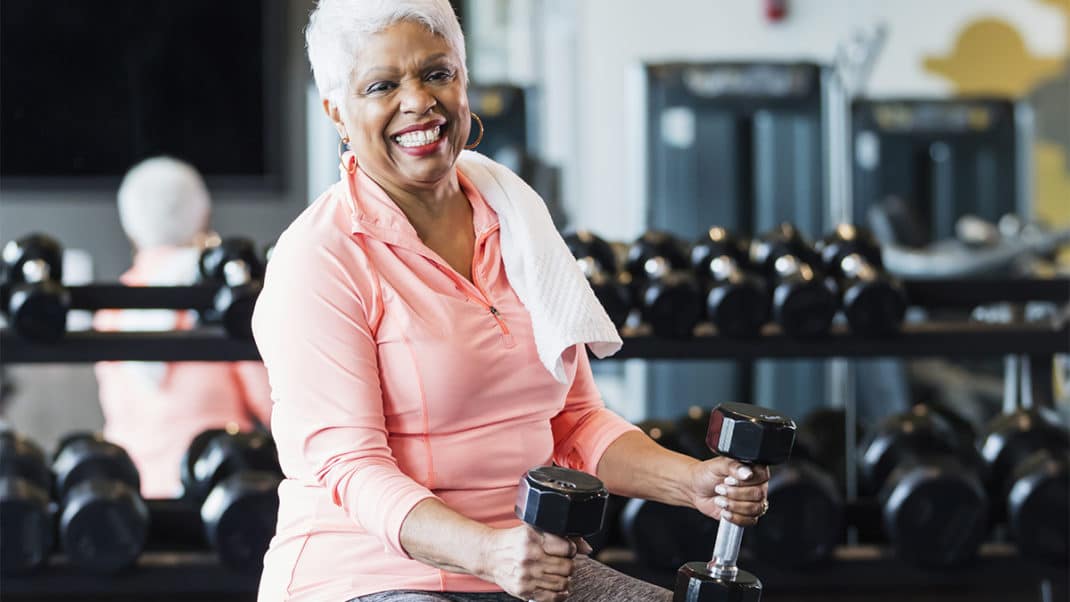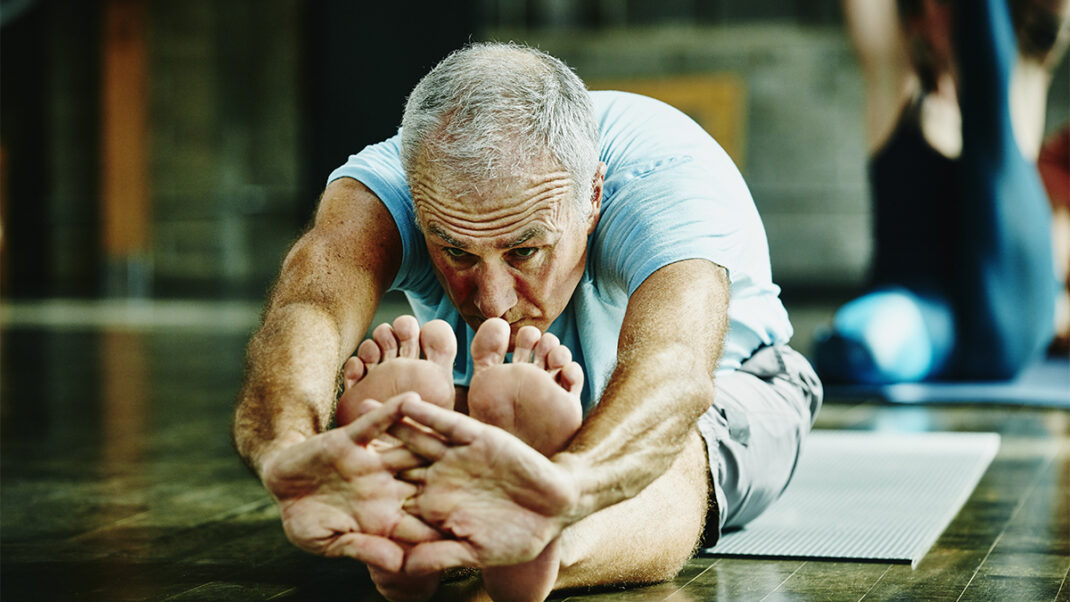Reshaping Senior Fitness Exercise
Senior fitness is more relevant and important than ever. See what it takes to deliver top-notch senior fitness programs!

When creating exercise programs for seniors, it is essential to consider their unique needs and limitations. This is critical for promoting longevity, enhancing mobility and improving their overall quality of life. To achieve these goals, fitness programs must be adapted to be more accessible, safer and effective for seniors. In this regard, we will explore effective strategies and sources highlighting the importance of reshaping senior fitness exercise.
Personalizing and Finding Your Senior Fitness Exercise Niche in Group Programs
Designing exercise programs that cater to seniors’ specific abilities and needs is crucial to ensuring activities are enjoyable and beneficial for everyone involved, regardless of their fitness level or health condition. With the right approach, fitness professionals can identify a senior fitness niche, adapt class formats to suit special populations, and create unique fitness programs that meet the needs and goals of older adults. By doing so, instructors can confidently develop programs that resonate deeply with their senior audience, providing them with personalized fitness experiences that are both safe and effective.
In senior fitness, success lies in recognizing and fulfilling the specific needs within the senior community through targeted niche programming. This approach enhances a facility’s value and positions it as a significant resource in improving seniors’ quality of life. The American College of Sports Medicine (ACSM) (n.d.) advises that personalization of programs is necessary. This can only be accomplished by understanding individual health statuses, physical capacities, and interests.
A comprehensive senior fitness program should provide a variety of Basic and Signature programs that cater to the unique needs of older adults. Basic programs are the foundation of most fitness routines and include popular activities such as step aerobics, yoga, and group cycling. These programs are designed to help anyone maintain an active and healthy lifestyle by improving their strength, flexibility and cardiovascular health. With various options, seniors can choose the programs that best suit their interests and fitness levels.
In contrast, Signature programs are unique to a facility and offer specialized classes that cater to specific niches within the senior population. These programs are one area where a facility can stand out from competitors, by providing unique and tailored services designed to meet the particular needs of older adults. Signature programs can include aquatic exercise, balance training and low-impact aerobics, customized to cater to any senior member’s fitness goals and abilities (Rhodes 2007). Creating Signature programs that stand out in the fitness market sets a facility apart and enhances its reputation for providing targeted fitness solutions. Developing Signature programs involves creativity and innovation, tailoring offerings that stand out and specifically cater to one’s unique niche. Perkins-Carpenter (2001) suggests that exercise programs for older adults should focus on balance, flexibility and stretching activities, which are foundational to senior mobility. However, incorporating these into Signature programs allows the fitness instructor to create something unique for their facility. Offering Signature programs in group fitness sessions can help participants improve their quality of life by addressing specific health concerns such as arthritis, diabetes and osteoporosis. Seniors can achieve their fitness goals through engaging, fun, and challenging Signature programs. With various programs to choose from, they can find the group fitness classes that are best suited to their needs, helping them maintain an active and healthy lifestyle well into their golden years.
Creating Signature Senior Programs For EVERY-BODY
Key Components in Specialized Group Exercise Formats
- Low-Impact Options: Integrate low-impact exercises that reduce joint strain while delivering cardiovascular, strength and flexibility benefits. Activities like water aerobics, chair yoga and Pilates, are ideal for seniors seeking gentle yet impactful workouts.
- Balance and Mobility: Focus on exercises that improve balance and mobility, crucial for preventing falls and enhancing overall physical function. Programs featuring tai chi, balance-focused yoga, or specialized balance sessions utilizing tools like stability balls or balance beams, aid in enhancing stability and coordination.
- Strength and Endurance Training: Develop classes to preserve or enhance muscle mass and endurance, essential for sustaining independence in daily tasks. Incorporate light weights, resistance bands or body weight exercises, with modifications available to suit individual abilities.
- Cognitive Engagement: Include activities stimulating mental acuity, such as dance classes or coordination and rhythm-based exercises. These engagements enhance cognitive function and provide participants with an enjoyable and mentally stimulating experience.
Creating Specialty Signature Programs for Specific Conditions
Musculoskeletal Pain: Tailor programs to address muscle weakness common in seniors with musculoskeletal pain, focusing on exercises that help distinguish between soreness and joint pain. Emphasize posture, joint mechanics, static stretching, and progressions to moderate-intensity resistance training.
Neurological Disorders: Design programs incorporating cardiorespiratory exercises, relaxation, flexibility activities and movement patterns, to potentially delay cognitive deterioration in individuals with neurological conditions. A meta-analysis of 19 research studies in humans found that cardiorespiratory exercise training may delay the deterioration in cognitive function of individuals who are at risk for, or those who have, Alzheimer’s disease (Panza et al. 2018). Instructors should prioritize simplicity, verbal encouragement, and focus on programming frequency and duration.
Post-Rehabilitation Needs: Develop safe and unique therapeutic programs that cater to individuals who have completed their rehabilitation, focusing on aiding recovery and improving fitness levels. Perhaps unsurprisingly, a large segment of the senior population requires muscular conditioning following injury, illness or surgery (Westcott & D’Arpino 2002). These programs can be customized for groups of individuals with similar injuries or conditions, whether on land or water. Additionally, these exercise programs should be performed under professional supervision to encourage a functional and active lifestyle while preventing reinjury.
By incorporating these key fitness components into class formats tailored to special populations, fitness professionals can create engaging, effective and safe programs, that address older adults’ unique needs and challenges, such as: musculoskeletal pain, neurological disorders, post-physical therapy needs and cognitive fitness.
Developing Signature Senior Fitness Exercise Classes
Designing senior fitness classes—particularly when creating Signature special populations fitness programs—requires intentional and thoughtful consideration toward their effective naming, development, and promotion. Below are some key considerations and strategies for successfully naming and marketing senior fitness classes.
Naming A Signature Senior Fitness Class:
Familiarity and Connection: Use names and words that resonate with seniors, aligning with their experiences and preferences.
Mission and Values Alignment: Ensure the class name reflects the facility’s business mission, values and goals, providing a clear indication of what participants can expect.
Inclusivity and Avoiding Stereotypes: Be mindful of gender stereotypes or misleading exercise physiology principles in fitness class names, focusing instead on positive body image and inclusive language.
Class Component and Experience:
Clarity in Type of Exercise: Lead with the type of exercise in the class name to set clear expectations on the movement style participants can anticipate.
Emotional Connection: Emphasize how participants should feel during and after the class, prioritizing a positive and inclusive experience.
Exercise Intensity: Clearly indicate the exercise intensity level in the name to help participants self-select the appropriate class for their preferences and abilities.
Required Skill Set and Inclusivity:
Skill Level and Inclusivity: Consider the necessary skills for participation and highlight them in the title to welcome newcomers and promote a balanced challenge.
Avoiding Body Image Connotations: Focus on the enjoyment of movement and health benefits, while steering clear of connotations related to body image or unrealistic fitness standards.
Describing, Designing, and Marketing Signature Special Populations Class:
Educational Approach: Effectively inform and engage potential participants by providing a clear description of the class’s purpose, format, frequency and value.
Engagement and Community Connection: Create an engaging class atmosphere that aligns with the values and goals of the facility, fostering a sense of community and care.
Life Enhancing Fitness Programs: Offer low-risk, high-reward fitness programs that enhance participants’ overall well-being and capabilities without limiting them.
By focusing on creating a welcoming, inclusive, and engaging environment through thoughtful class naming, design and marketing strategies, fitness instructors can attract and retain participants while providing a positive and beneficial fitness experience for seniors in special populations.
Building Community in Your Signature Classes and Beyond
Creating a sense of community among participants in senior fitness classes can significantly enhance their experience and motivation. Fitness instructors who work with seniors can cultivate this sense of community by focusing on the specific aspects listed below.
Make It Approachable:
Welcoming Environment: Create a warm and inclusive atmosphere where all participants feel valued and comfortable.
Clear Communication: Use simple language, provide clear instructions, and encourage everyone to feel welcome and supported.
Add a Technological Element
Technology Integration: Fitness trackers, smartphone apps, and virtual platforms can be used to follow progress, set goals, and foster community beyond the physical class setting (see sidebar, Encouragement Tips for Technology Usage). Seniors can benefit greatly from these technologies as they can be motivated and supported in their physical activity with the help of wearable devices, fitness apps and virtual fitness classes.
Utilize Online Platforms: Create social media groups, online forums, or chat groups for participants to share progress, tips and encouragement outside class.
Make Classes Enjoyable and Social:
Fun and Varied Activities: Create a variety of exercises that are not only engaging, but also enjoyable for everyone involved. Incorporate exercises catering to different preferences to ensure everyone feels included and no one feels left out. Maintain a light and positive atmosphere throughout the activities to keep the participants motivated and focused.
Music and Laughter: Incorporate music and elements of joy and laughter to make the fitness experience enjoyable and uplifting.
Create Great Memories:
Encourage Bonding Activities: Facilitate group activities, partner exercises or shared experiences, that create lasting memories and strengthen participant connections.
Celebrate Milestones: Organize social events, special classes or recognition ceremonies, to mark achievements and create memorable experiences.
Show Your Authentic Self:
Authenticity: Bring your genuine self to the class, displaying compassion, enthusiasm and empathy, to foster a safe and trusting environment for all participants.
Encourage Connection: Facilitate interaction, communication and sharing of experiences among participants, to build a sense of community and support.
Lead by Example: Demonstrate positivity, authenticity and a passion for fitness, to inspire and connect with participants on a personal level.
By incorporating these strategies, senior fitness instructors can create a vibrant and supportive community within their classes, fostering connection, motivation, and well-being among participants.
Senior fitness programs must be designed to be inclusive, adaptable and comprehensive. They should cater to seniors’ physical, cognitive and social needs, while adhering to evidence-based practices and recommendations from reputable health organizations and professionals. By doing so, fitness specialists can help reshape special population exercise by leading older adults into healthier and more active lifestyles.
Want to learn more? Help Prevent Negative Effects of Aging
Ruben Pereyra Biography
Ruben Pereyra is the Senior Fitness Director at WESLEY Senior Homes in Des Moines. He holds a BS degree in Kinesiology and is a certified ACE personal trainer, Parkinson’s Fitness Specialist, Senior Fitness Specialist, WA Certified Coach, and Speaker specializing in Senior Populations. For the past 16 years, Ruben has been an influential figure in the fitness industry, spreading awareness about the importance of movement and how it can positively impact people’s lives. Ruben is an entrepreneur who offers fitness services for every age group, including personal training, group exercise classes, brain cognitive function training, and fitness direction for schools and well-known corporations.
Encouragement Tips for Technology Usage:
Ease into Technology:
Start with the basics and gradually introduce more advanced technologies as the senior becomes more comfortable.
Highlight Personal Benefits:
Focus on the ways in which technology can improve health, such as providing exercise reminders, tracking progress, and offering visual demonstrations of mobility-friendly exercises.
Provide Support and Education:
Be patient and provide continuous support and guidance. Hold multiple sessions explaining how devices work to ensure the senior feels confident using new technologies.
Customize Settings:
Adjust the settings on devices and apps to enhance readability and ease of use, such as increasing text size or changing contrast.
Focus on Fun:
Encourage clients to try technologies that make exercise fun; interactive video games designed for fitness, such as those available on platforms like Nintendo Switch. These games also have tracking features so participants can monitor their progress and stay motivated.
Resources for Getting Started:
Local Senior Centers: Many have programs that help seniors learn to use technology, often at little to no cost.
Technology Tutorials: Websites like TechBoomers or AARP offer free tutorials on using various technologies, including fitness trackers and apps.
Family Involvement: Getting family members involved in teaching, and participating in, technology-based activities can make the learning process more reassuring and less daunting.
References
References:
ACSM (American College of Sports Medicine). n.d. Guidelines for Exercise Testing and Prescription. Accessed March 15, 2024. acsm.org/education-resources/trending-topics-resources/physical-activity-guidelines.
Panza, G.A., et al. 2018. Can exercise improve cognitive symptoms of Alzheimer’s disease? A meta-analysis. Journal of the American Geriatrics Society, 66(3), 487-495.
Perkins-Carpenter, B. 2001. Balance & Stretching Programs for Seniors. Fitness Management. Accessed March 18, 2024. fitnessmanagement.com/FM/tmpl/genPage.asp?p=/information/articles/library/oldadults/seniorstretch0201.html.
Rhodes, J. (2007). Developing and marketing adult exercise programs. ACSM’s Health & Fitness Journal, 11(2), 13-14.
Westcott, W.L., & D’Arpino, R. 2002. Muscular conditioning for post-rehabilitation clients. Strength and Conditioning Journal, 24(2), 33-37.





